

Udl diy template. TAKE A TOUR: LEARN ABOUT UNIVERSAL DESIGN FOR LEARNING. Take a Tour was developed by CAST in collaboration with the IDEA Partnership and through the generous support of the Massachusetts Department of Elementary and Secondary Education.
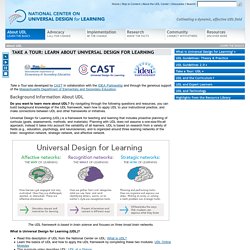
Background Information About UDL Do you want to learn more about UDL? By navigating through the following questions and resources, you can build background knowledge of the UDL framework, learn how to apply UDL to your instructional practice, and make connections between UDL and other frameworks or initiatives. Universal Design for Learning (UDL) is a framework for teaching and learning that includes proactive planning of curricula (goals, assessments, methods, and materials). Planning with UDL does not assume a one-size-fits-all approach; instead it takes into account the variability of all learners. About Universal Design for Learning. UDLupdateguidelines2 0. Using UDL to Accurately Assess Student Progress. UDL On Campus: Getting Started. (music) [The words UDL On Campus: Getting Started appear on the screen.
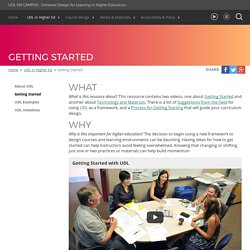
Manju Banjeree, Director of Landmark College, is seated in an office.] MANJU BANERJEE: So one advice to getting started with UDL is to take it in small steps and then pick an actual scenario. Don't be hypothetical. Pick a situation in your class today that you want to address or you want to change and start with that. [Gabrielle Rappolt-Schlichtmann, Co-President of CAST, appears. GABRIELLE RAPPOLT-SCLICTHMANN: I really focus on creating very tight goals that are very clear and then building multiple means by which students can operate on those goals across the course and within each session.
[Sam Johnston, Research Scientist at CAST, appears on the screen.] SAM JOHNSTON: The key thing is really making sure that your students are helping you drive the changes that you're going to make. UDL On Campus: About UDL. (music) [Title: UDL On Campus, Gabrielle Rappolt-Schlichtmann, Co-President of CAST, appears on the screen.]
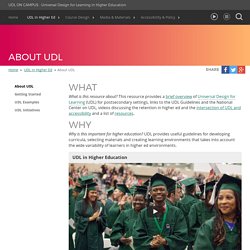
GABRIELLE RAPPOLT-SCLICTHMANN: Learning is really a lifelong journey and when students come to postsecondary they're incredibly diverse. They have a wide range of strengths and weaknesses and UDL is really about how to make that learning journey tractable for as many of those learners as possible. [Students sit in a circle on a lawn on a college campus.
The scene changes to a large display of artwork. SKIP STAHL: UDL is important because of the variability that we have across learners. [The screen shows students gathered around tables in a student center, then a student taking a picture, followed by many students standing and smiling during graduation in green caps and gowns. [Students are gathered around a table with papers and laptops. MANJU BANERJEE: It is not about faculty being the experts or administrators being the experts but the ethos of we're all in this together. UDL On Campus: UDL Syllabus. [The video opens to a screen recording of the interface of a web conferencing system.
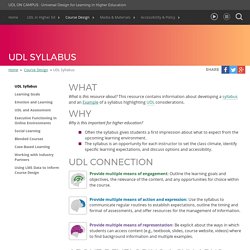
There is a small video window in the upper-left corner, in which we can see a female instructor self-recording the video feed. Below is a window showing Participants, and below that is a window displaying a live Chat feed. To the right of these windows is a slide window, which is taking up most of the screen. The slide shown here is entitled “Welcome to Algebra 114.” The body of the slide consists of a photograph of a young professional adult, with corresponding text that reads: “Michelle Benson-Young; mbensonyoung@college.edu; (555) 381–2281; Office Hours: Tuesdays and Thursdays from 11:00 a.m.-12:30 p.m.; Find me on Twitter @math114; Skype: MBenson-Young.”]
MICHELLE BENSON-YOUNG: Welcome to Algebra 114, I am Michelle Benson-Young, your class instructor. [The next slide appears; this one entitled “Student Resources.” [The next slide is entitled “Course Description.” UDL On Campus: Learning Goals. What What is this resource about?
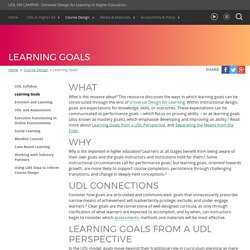
This resource discusses the ways in which learning goals can be constructed through the lens of Universal Design for Learning. Within instructional design, goals are expectations for knowledge, skills, or outcomes. These expectations can be communicated as performance goals -- which focus on proving ability -- or as learning goals (also known as mastery goals), which emphasize developing and improving an ability.1 Read more about Learning Goals from a UDL Perspective, and Separating the Means from the Ends. UDL On Campus: UDL and Assessment.
[White text appears on magenta background: "UDL On Campus.”
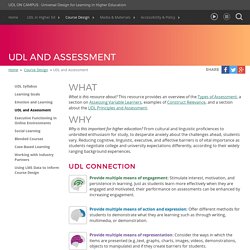
The colors are inverted and a wave of orange slides over the “UDL On Campus” magenta text. Grey text appears below: “Universal Design for Learning in Higher Education.”] UDL On Campus: Using LMS Data to Inform Course Design. Why Why is this important for higher education?

An iterative relationship between data analysis and course design results in refined efforts at addressing learner variability and engaging all students – and, as such, increasingly effective instructional environments. UDL Connection A UDL approach to data analytics includes three key components: emphasis on data to improve the learning environment rather than an individual student interpretation of data through the lens of the three UDL principles use of data to take action to make improvements to a course Example This video describes the process of designing courses to utilize learning management system data.
Types of Data The types of data that are most widely available in Learning Management Systems (LMSs) can be classified into three broad categories: demographic data, usage data, and achievement data. UDL On Campus: Blended Courses. Why Why is this important for higher education?

There are many opportunities in higher education settings to leverage technology to create both face-to-face and online learning environments, but there are important pedagogical and accessibility considerations to make these setting successful. UDL On Campus: Media & Materials. UDL Explainer. UDL At A Glance START. UDL in Higher Education. CAST Universal Design for Learning in Postsecondary Education Video. UDL: Reducing Barriers.